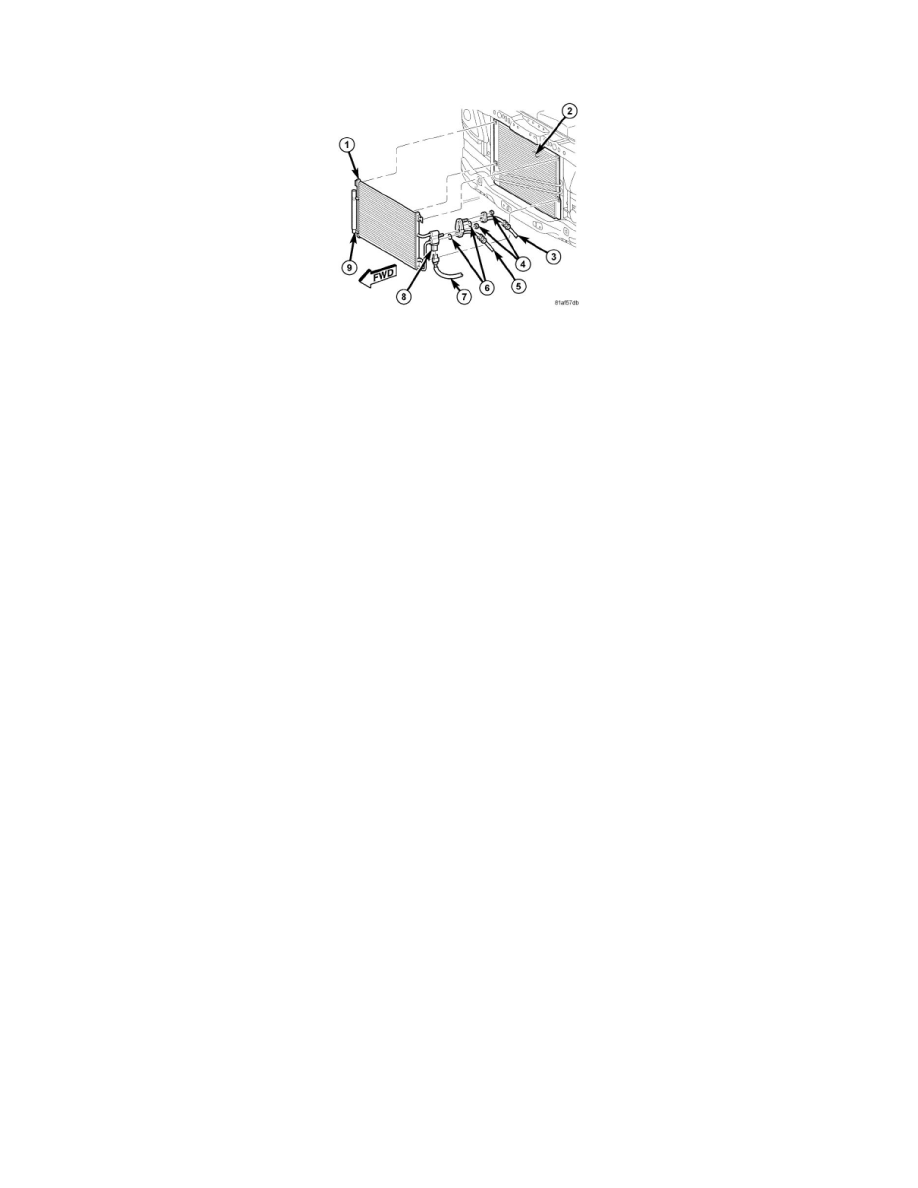Sprinter 3500 V6-3.0L DSL Turbo (2008)

NOTE: Replacement of the refrigerant line O-ring seal is required anytime a refrigerant line is disconnected. Failure to replace the rubber
O-ring seals may result in a refrigerant system leak.
1. If removed, install the A/C pressure transducer (8) onto A/C condenser (1) using a new O-ring seal. Tighten the sensor to 10 Nm (88 in. lbs.).
2. If removed, install the A/C receiver/drier (9) onto the A/C condenser See: Receiver Dryer/Service and Repair/Plumbing - Front/Installation See:
Receiver Dryer/Service and Repair/Plumbing - Rear/Installation.
3. Carefully install the A/C condenser into the engine compartment and engage the condenser mounting brackets to the radiator (2). Make sure the
brackets are fully engaged.
4. Position the top of the radiator forward and engage the retaining tabs that secure the radiator to the radiator support. Make sure the retaining tabs
are fully engaged.
5. On diesel engine equipped models, connect the hoses to the charge air cooler and install the two front air seals to the front of the charge air cooler.
6. Connect the wire harness connector (7) to the A/C pressure transducer.
7. Remove the tape or plug from the opened refrigerant line fittings and condenser ports.
8. Lubricate new rubber O-ring seals (6) with clean refrigerant oil and install them onto the refrigerant line fittings. Use only the specified O-rings as
they are made of a special material for the R-134a system. Use only refrigerant oil of the type recommended for the A/C compressor in the vehicle.
9. Connect the A/C liquid line (5) to the A/C condenser.
10. Install the nut (4) that secures the A/C liquid line to the A/C condenser. Tighten the nut to 6 Nm (53 in. lbs.).
11. Connect the A/C discharge line (3) to the A/C condenser.
12. Install the nut that secures the A/C discharge line to the A/C condenser. Tighten the nut to 6 Nm (53 in. lbs.).
13. Install the A/C condenser fan assembly See: Condenser Fan/Service and Repair/Plumbing - Front/Installation See: Condenser Fan/Service and
Repair/Plumbing - Rear/Installation.
14. Install the grille See: Body and Frame/Grille/Service and Repair/Grille - Installation.
15. Connect the transmission cooler lines to the passenger side of the radiator.
16. Install the engine cooling fan and fan shroud See: Engine, Cooling and Exhaust/Cooling System/Radiator Cooling Fan/Service and
Repair/Radiator Fan - Installation.
17. Install the engine cooling system reservoir See: Engine, Cooling and Exhaust/Cooling System/Coolant Reservoir/Service and Repair/Coolant
Recovery Container - Installation.
18. Connect the upper radiator hose to the radiator.
19. Reconnect the negative battery cable.
20. Refill the engine cooling system See: Engine, Cooling and Exhaust/Cooling System/Service and Repair.
21. Evacuate the refrigerant system See: Service and Repair/Refrigerant System Evacuate.
22. If the A/C condenser is being replaced, add 30 milliliters (1 fluid ounce) of refrigerant oil to the refrigerant system. When replacing multiple A/C
system components, refer to the Refrigerant Oil Capacities chart to determine how much oil should be added to the refrigerant system See: Service
and Repair/Refrigerant Oil Level. Use only refrigerant oil of the type recommended for the A/C compressor in the vehicle.
23. Charge the refrigerant system See: Service and Repair/Refrigerant System Charge.
24. Install the air cleaner housing See: Engine, Cooling and Exhaust/Engine/Tune-up and Engine Performance Checks/Air Cleaner Housing/Service
and Repair.
